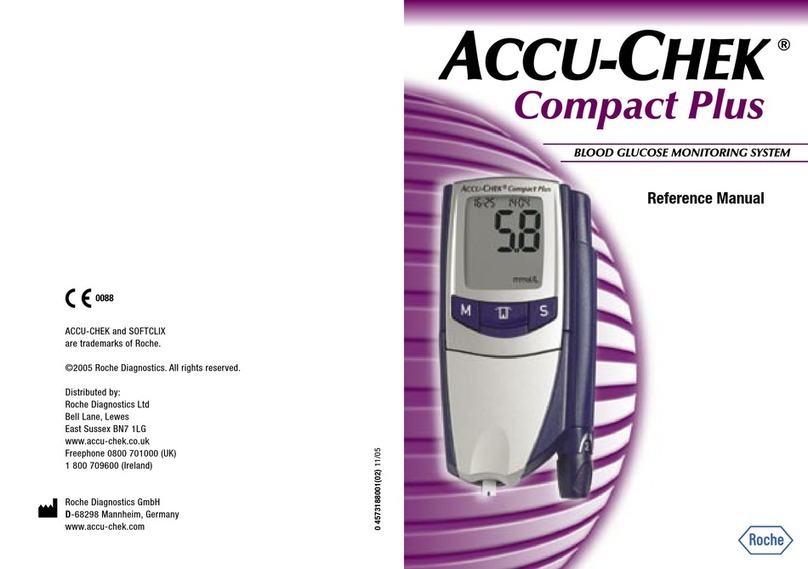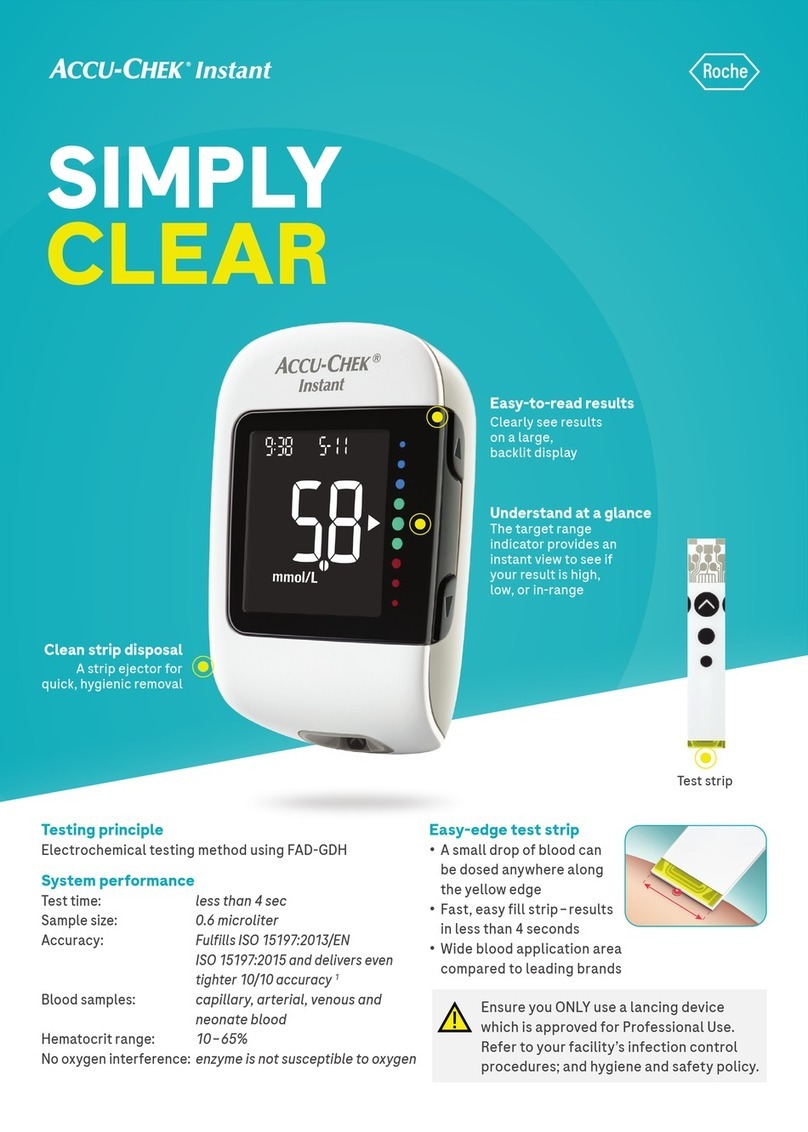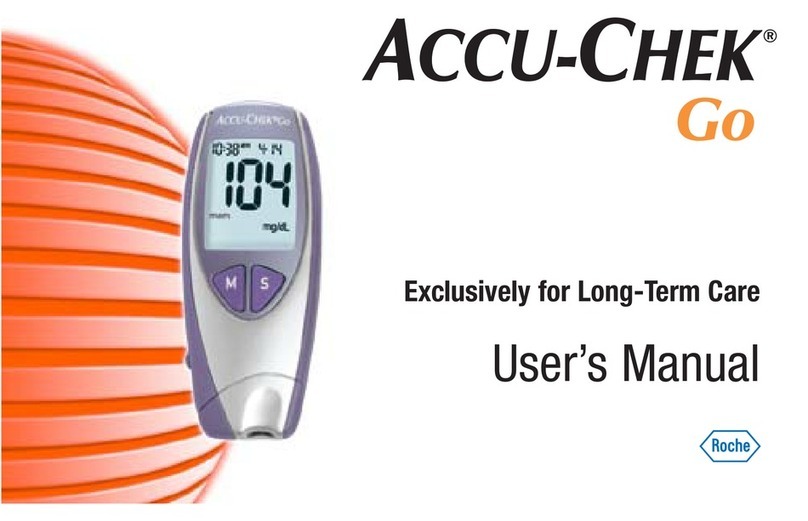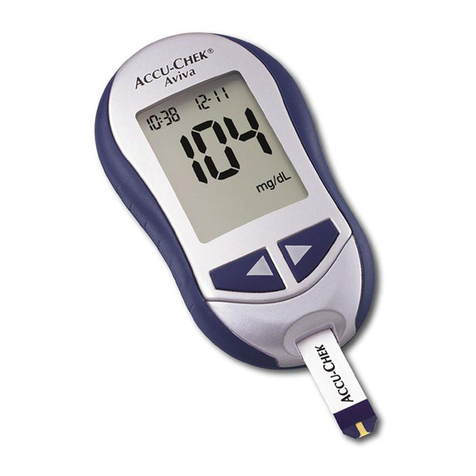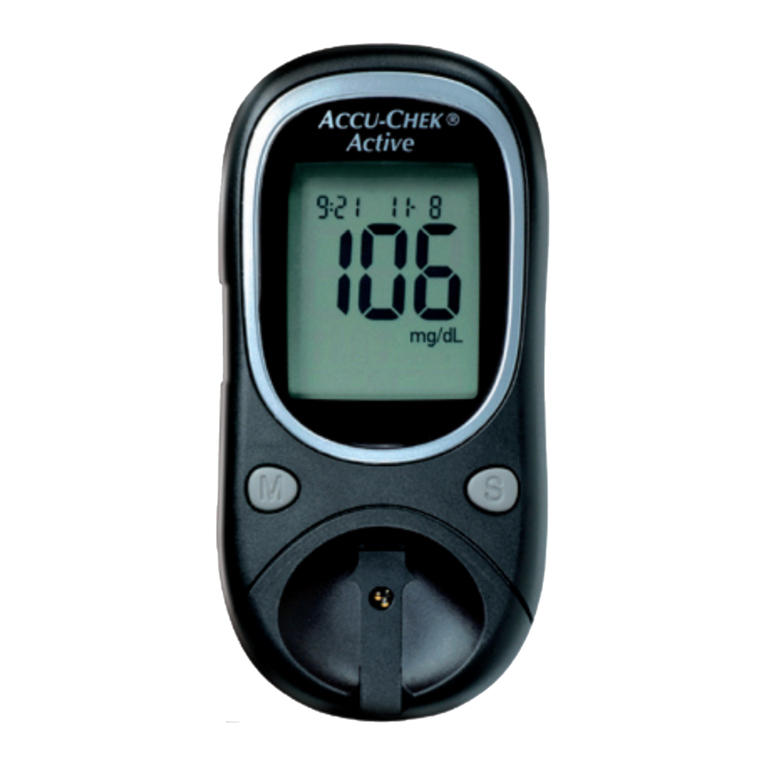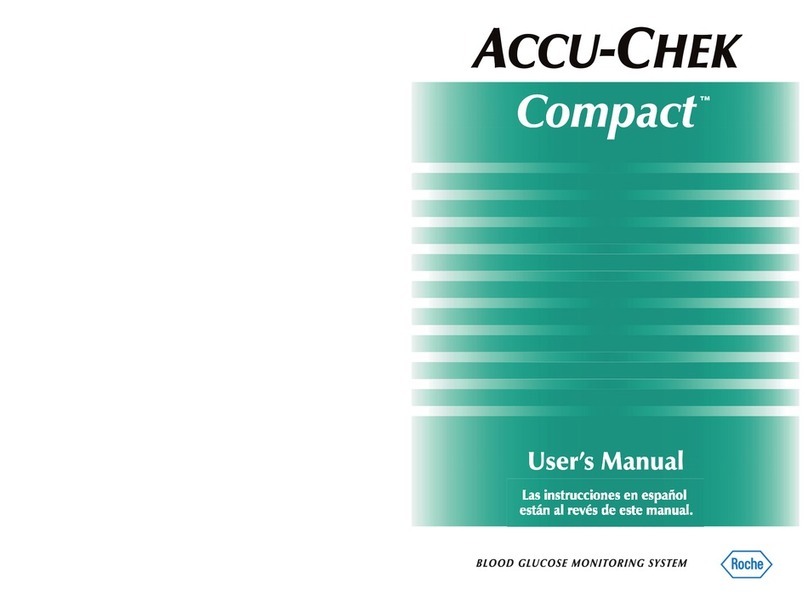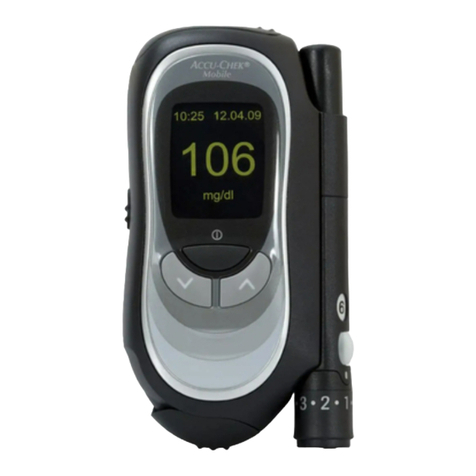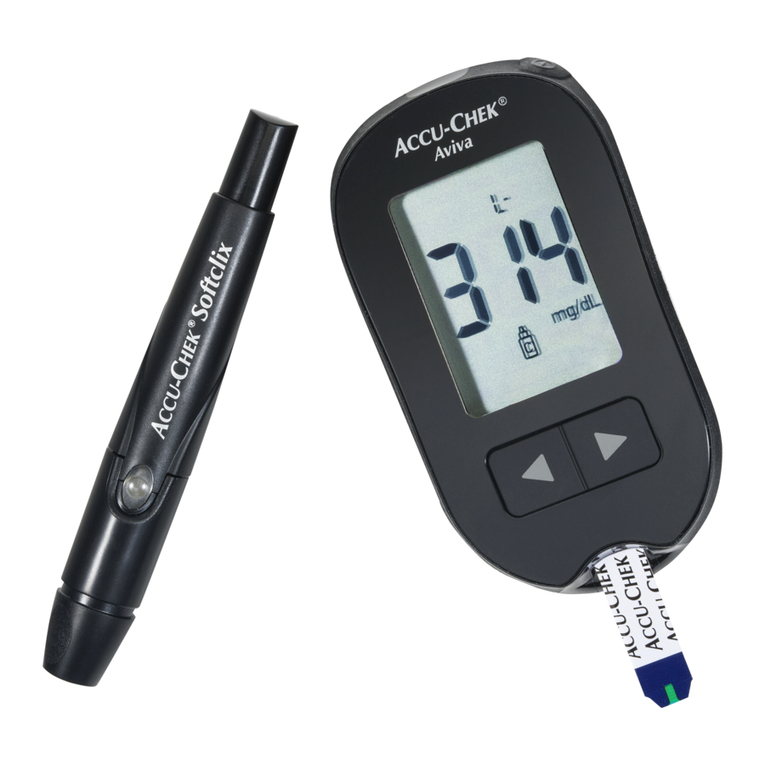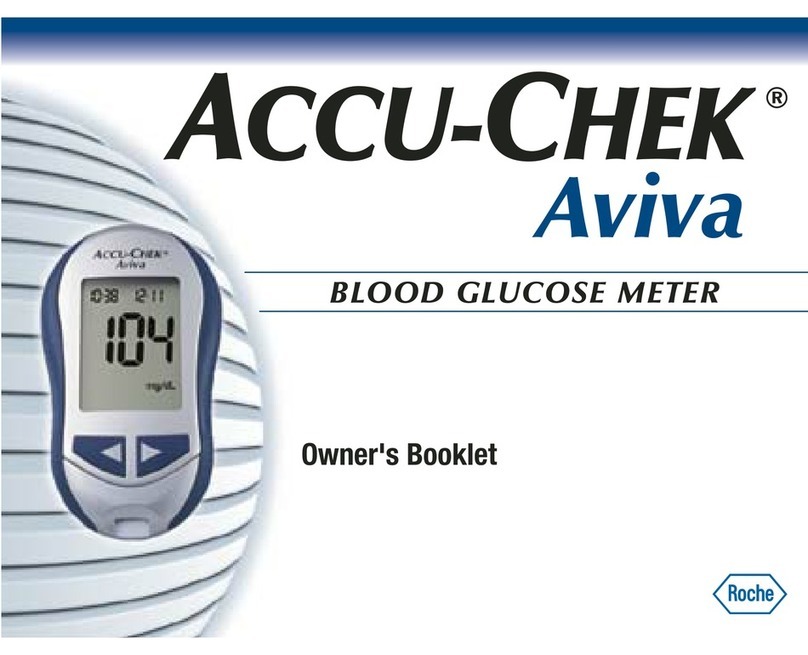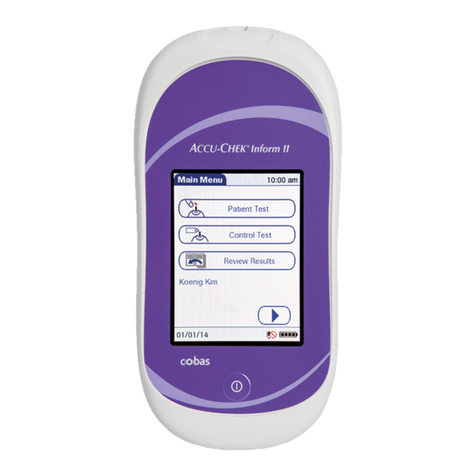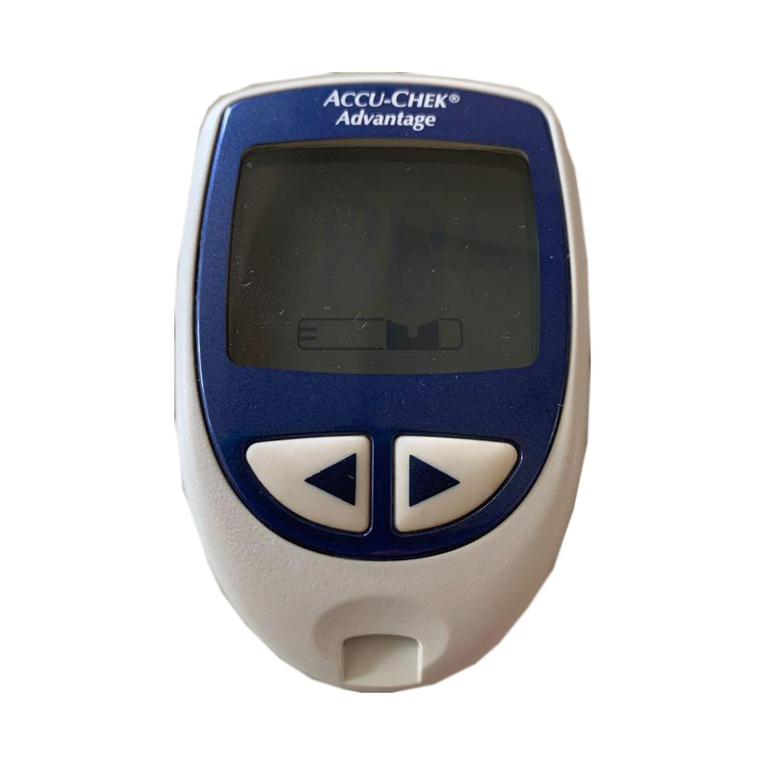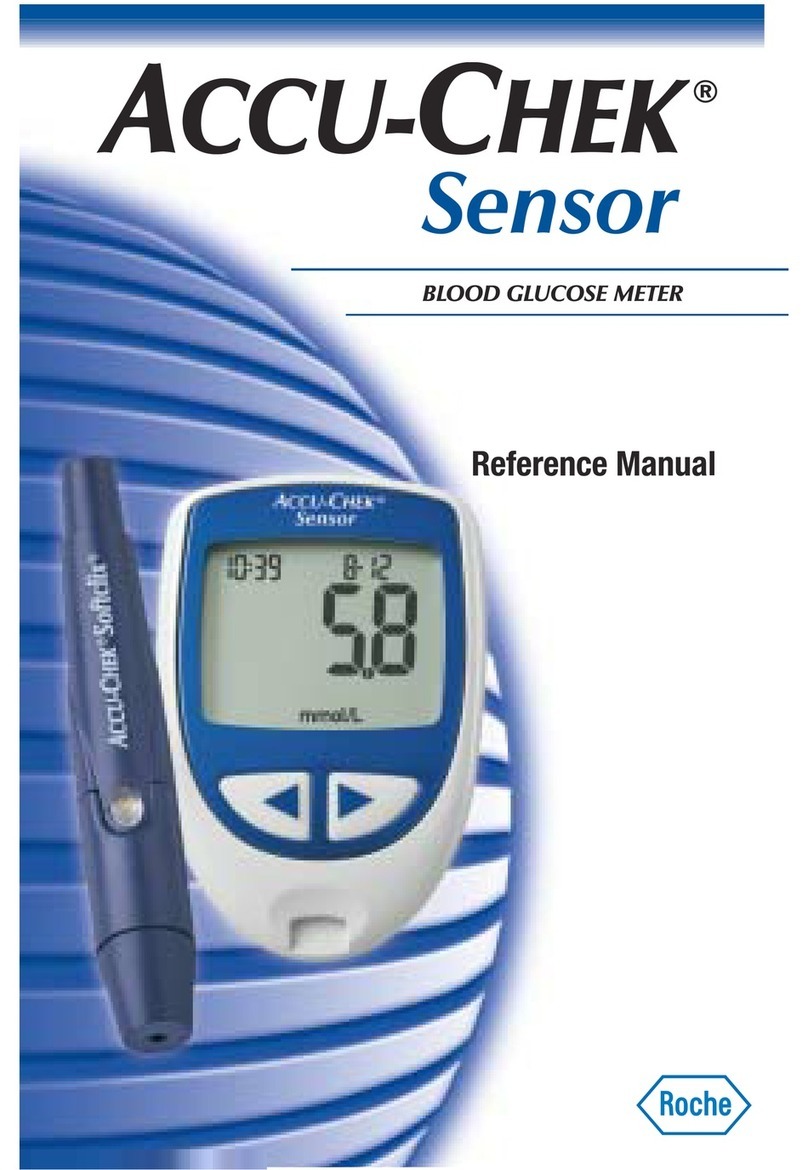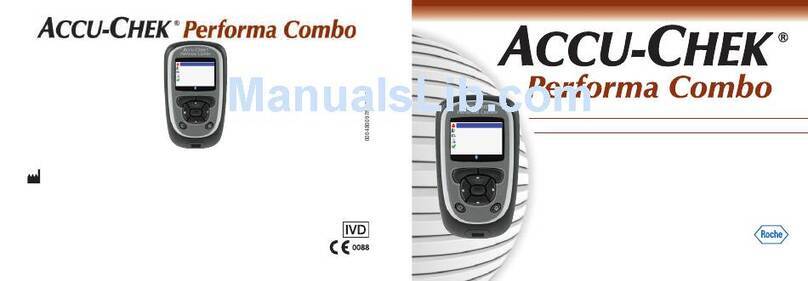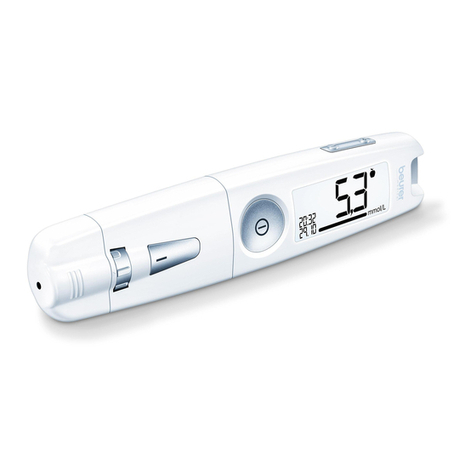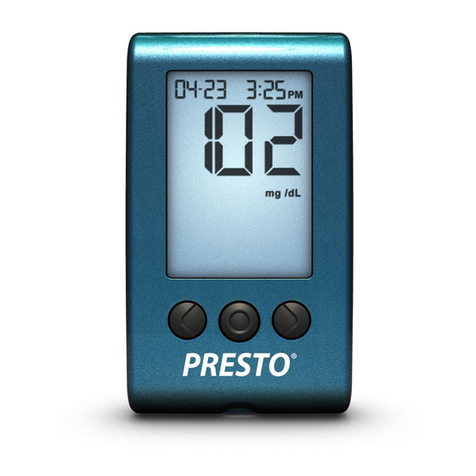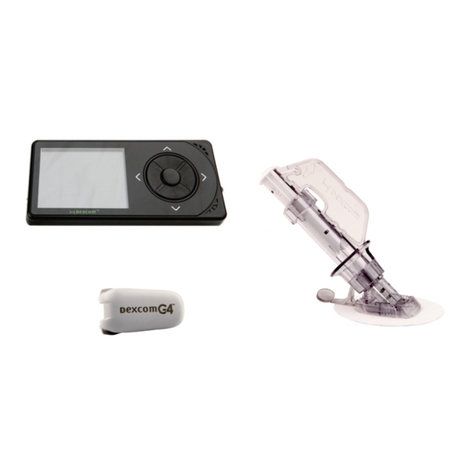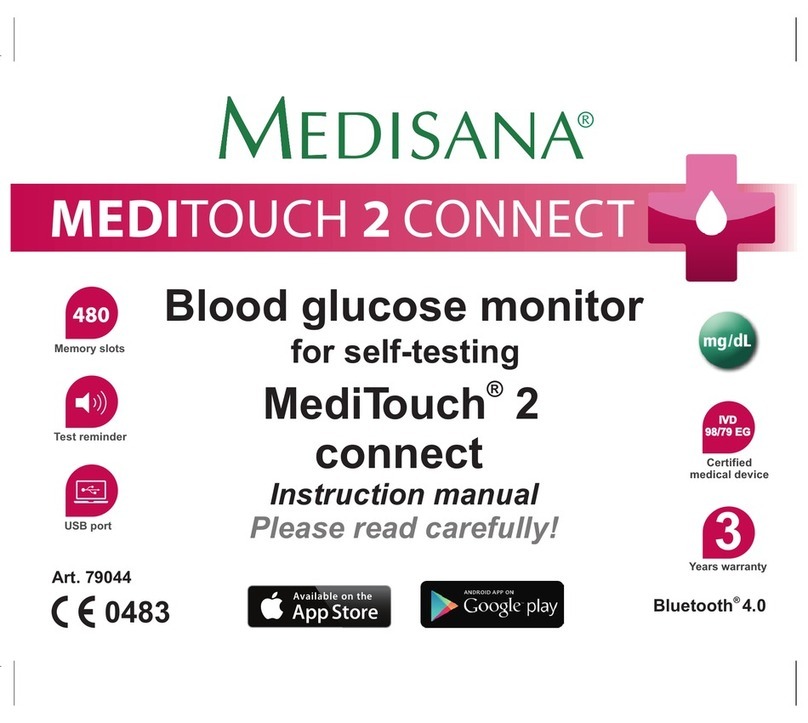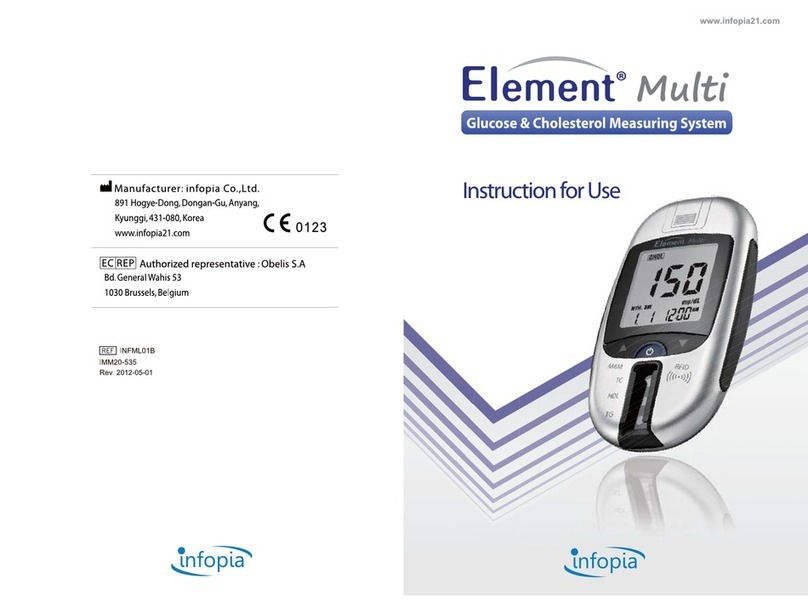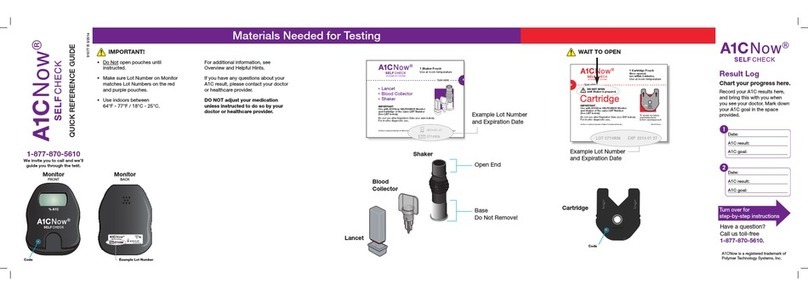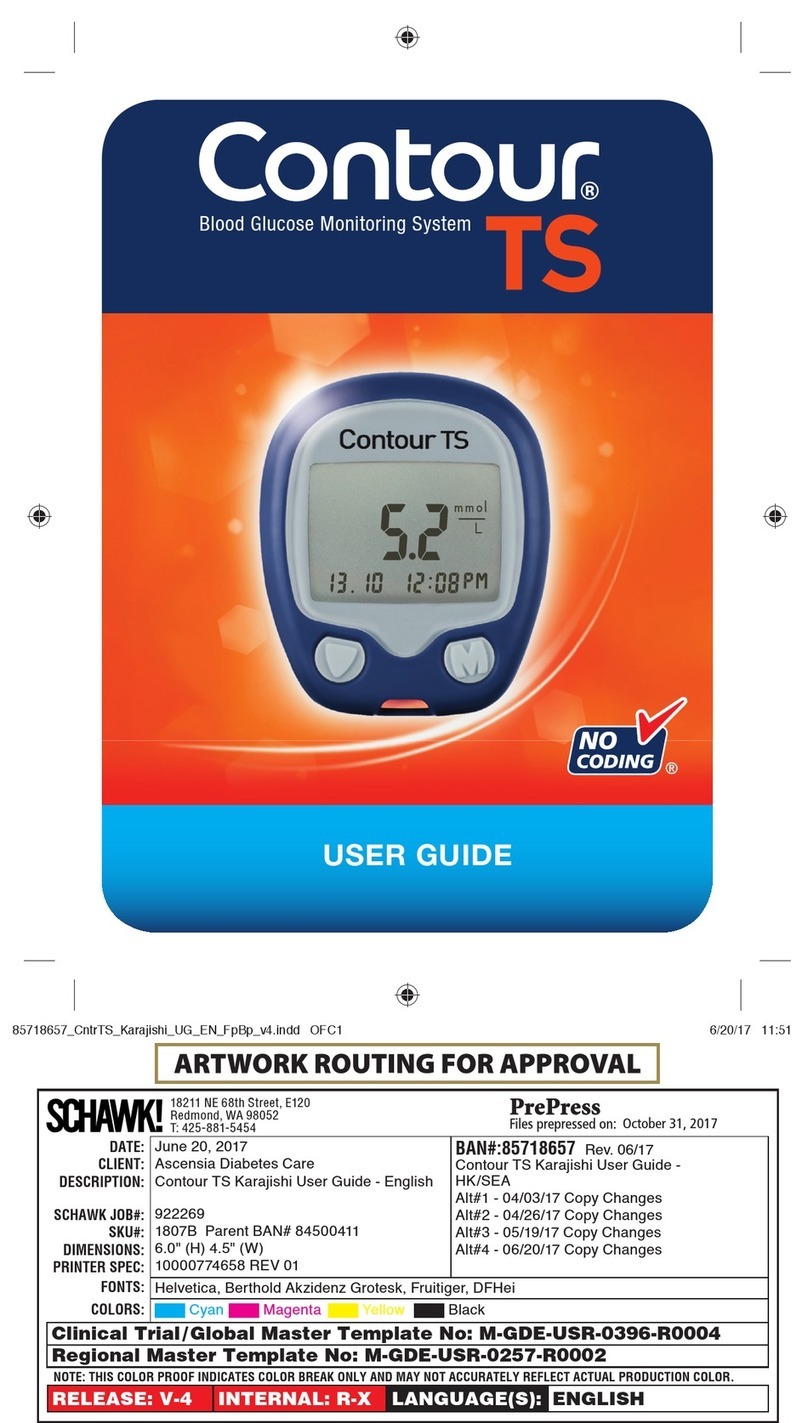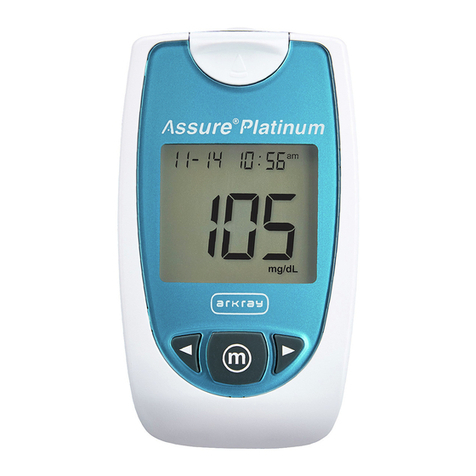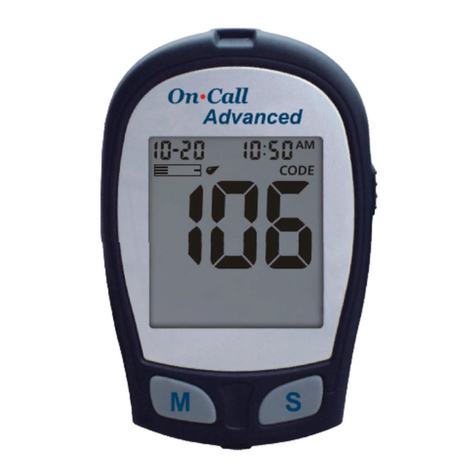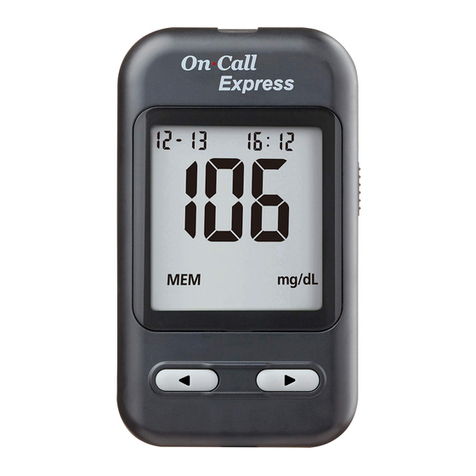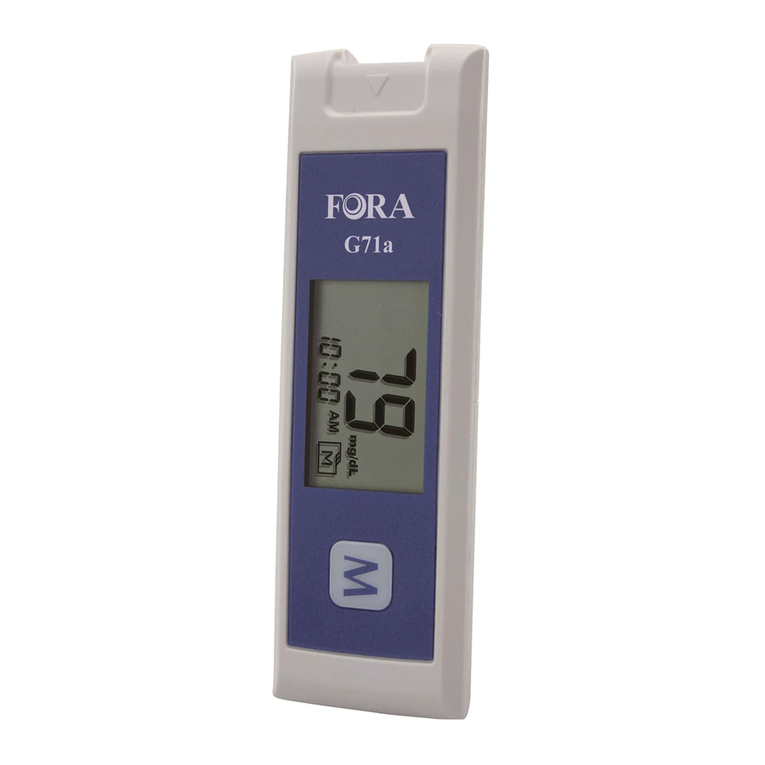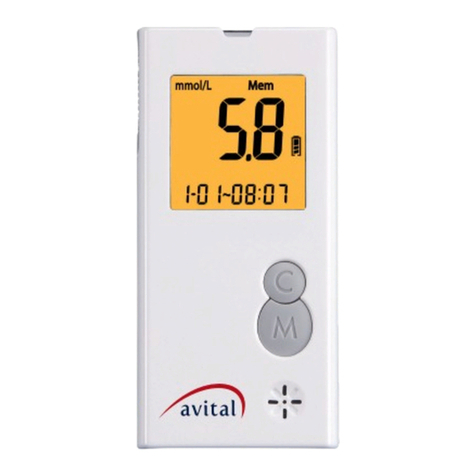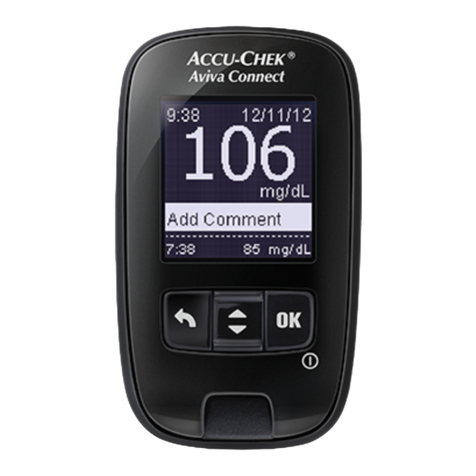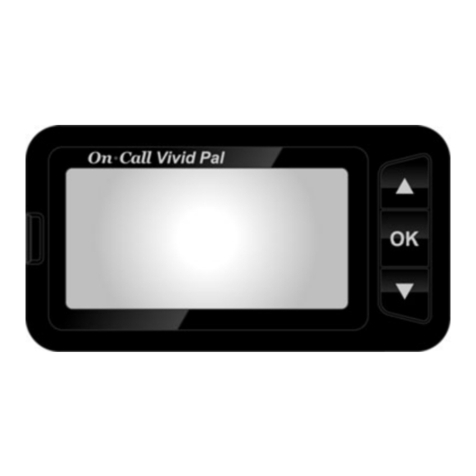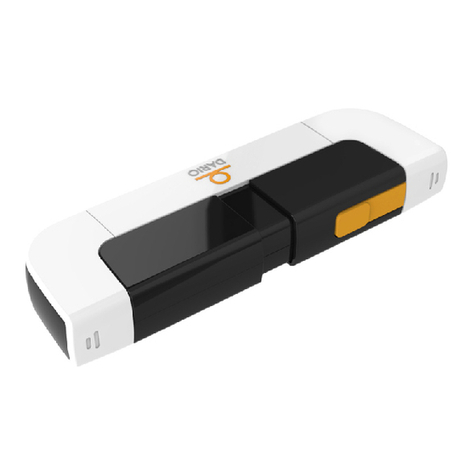LANCING DEVICE
Instructions for Use
The ACCU‑CHEK Multiclix lancing device uses a lancet to obtain a drop of blood from a
ngertip or other site. It is designed to make obtaining a drop of blood as comfortable as
possible. The lancing device is loaded with a drum containing 6 sterile lancets. For
virtually pain-free testing, we recommend that you advance to a new, sterile lancet after
each test. You can adjust the lancet depth to your individual skin type by dialing 1 of the
11 settings. There are 2 different caps: 1 is for a ngerstick, and the other is for other
sites on the body. Refer to your meter owner’s booklet to determine what other sites are
approved for your meter.
The colored cap is for ngerstick testing only.
The clear cap is for testing from other sites of the body,
not the ngertip.
Note: The ACCU‑CHEK Multiclix cap was not designed to be replaced after each
use. The ACCU‑CHEK Multiclix lancing device is intended for use by a single person
and is not suitable for testing multiple persons due to the risk of infections.
Inserting a Lancet Drum
You must rst insert a lancet drum into the lancing device to get it ready for use.
A new drum has a blue ring that does not move.
A used drum has two visible red stripes and the blue ring can
rotate on the white drum. You cannot insert a used drum into the
lancing device.
1 Remove the cap by pulling it
straight off. It is not a twist cap.
The easiest way to do this is to
place your thumb on the cap
grippers to the side of the notch
as seen in the illustration.
2Before you insert a drum, be sure
that the release button is not
yellow. Insert a new drum, blue
ring rst, until it stops. It clicks
into place.
3 Slide the cap back on until it stops
by aligning the notch on the cap
with the notch on the device.
4 You are now ready to use the rst
lancet. The lancet counter window
on the plunger shows the number
6, which means you have 6 new
lancets remaining.
Performing a Fingerstick
Use a new lancet for each ngerstick. When you use a new lancet each time, you avoid
infection and get a virtually pain-free test.
1 Make sure the colored cap is on the lancing device. Do not use the clear cap for
ngerstick testing.
2 Adjust the depth by turning the
comfort dial. The depth indicator
shows the current depth selection.
Higher numbers make the
penetration deeper. If you have
soft skin, start at a depth of 2. If
your skin is calloused or thick, try
a higher setting.
3Press the plunger in as far as it
will go, like a pen.
4 The release button turns yellow. Do not press the release button while pressing the
plunger.
5 Wash and dry your hands. Warm water helps to increase blood ow. If you use an
alcohol wipe, be sure your nger is completely dry before continuing.
6 Hold the lancing device rmly
against the side of your ngertip.
Remember that the opening where
the lancet comes out is not in the
center of the cap. Note: The side
of your ngertip is less sensitive
than the middle.
7 Press the yellow release button.
8 Gently squeeze your nger to
assist the ow of blood. This helps
you to get a blood drop.
9 Apply the blood drop to your test strip.
0 If you don’t get enough blood, try putting more pressure on your nger with the cap
or switch to a higher setting. If you get too much blood, switch to a lower setting.
Loading the Next Lancet
1 Twist the plunger one quarter turn
forward (until it stops), then twist
it back all the way. The lancet
drum rotates to the next lancet.
2The number in the lancet counter
window decreases by 1 and now
shows the number 5.
3 Each time you use a lancet and twist the plunger, the number showing in the lancet
counter window decreases by 1. When the number 1 is visible in the lancet counter
window, you have used 5 lancets. The sixth (and nal) lancet is loaded and ready to
be used.
Notes:
Only twist the plunger when the lancing device is not primed. You can see if the
lancing device is primed by the color of the release button. A primed device has a
yellow release button. When the lancing device is primed, the drum cannot rotate
and twisting the plunger would damage the device. In rare cases, the lancet could
protrude from the cap and you could injure yourself on it.
Only twist the plunger when at least “2” is displayed in the lancet counter window.
If the number displayed in the lancet counter window is “1,” the last lancet is ready
to be used.
A built-in safety block stops you from twisting the plunger when the lancet counter
window displays “1,” indicating there are no lancets left to load.
Do not twist the plunger forcibly past the safety block. Damage to the lancing device
may occur. This can override the protection against reusing used lancets.
For safety reasons, once you advance to a new lancet, you cannot go back to a
previously used lancet. Therefore, the plunger (and drum) cannot be twisted
backwards. This built-in safety block prevents an infection risk, as used lancets
cannot be reused.
Changing the Lancet Drum
When you have used the sixth and last lancet, you should change the drum.
1 Take the colored cap off the lancing device by pulling it straight off. It is not a twist
cap. The easiest way to do this is to place your thumb to the side of the notch as
seen in the illustration.
2 Hold the drum between your
thumb and index nger and pull it
straight out of the lancing device.
Two red stripes are visible on the
white drum, indicating that the
drum has been used.
3 Used lancet drums should always be disposed in accordance with local regulations.
4 Insert a new drum, blue ring rst,
until it stops and clicks into place.
Notes:
Due to safety reasons, a used drum cannot be reinserted into the lancing device.
A built-in safety block prevents this. This rules out a potential infection risk.
In rare instances, if a used drum is dropped on a hard surface, the lancets may
protrude slightly from the drum. If you drop a drum, always pick it up at the red-
striped end.
Getting Blood from a Site Other Than Your Fingertip
Capillary blood for blood sugar testing can be obtained not only from the ngertips but
also from other sites (the palm, the forearm, the upper arm, the calf or the thigh), which
is referred to as alternative site testing (AST). We recommend palm as the nonngertip
test site.
Use the clear ACCU-CHEK Multiclix AST cap together with the ACCU-CHEK Multiclix
lancing device to collect blood from nonngertip test sites.
Your ACCU-CHEK blood glucose monitoring system is designed to test blood glucose also
from sites other than your ngertip. Please refer to your test strip insert or your meter
owner’s booklet for specic blood glucose and AST testing instructions.
IMPORTANT – There is a delay (lag time) in the delivery of blood glucose to nonngertip
sites when compared to ngertip. Therefore, there is a potential for a signicant
difference between ngertip and AST results. The length of delay (lag time) is strongly
impacted by lifestyle, foods eaten or any other event having impact on blood glucose
levels. It is important that people considering nonngertip testing understand the
following:
Talk to your doctor if you are considering testing on sites other than your ngertip.
AST is not recommended during periods of rapid decreases or increases in blood
glucose levels.
AST is not recommended for people with a history of recurrent hypoglycemia, who
suspect their blood glucose is extremely low, or who are unaware of hypoglycemic
events.
Never ignore symptoms of high or low blood sugar.
Do not change your treatment based on one result.
If the AST reading does not match how you feel, perform a ngertip test to conrm
your results. If your blood glucose still does not reect the way you feel, contact
your doctor. For more information on AST please contact the ACCU-CHEK Customer
Care Service Center at 1-800-858-8072.
Do not test blood from the alternative sites:
U
p to 2 hours following a meal, when blood glucose values can change quickly
A
fter exercise
I
f you have a temperature or if a medical condition is limiting your mobility, e.g. after
breaking a leg or being conned to bed
If you suspect that your blood glucose is extremely low (hypoglycemia)
D
uring peak action time of short-acting insulin (up to approximately 4 hours after
the injection) or rapid-acting insulin analogues (up to approximately 2 hours after
the injection)
1 Remove the colored cap from the lancing device by pulling it straight off.
2Put the clear cap on by lining up the notched sections on the cap and the lancing
device.
3 Adjust the depth setting dial to the highest setting (5.5).
4 Press the plunger in as far as it will go, like a pen.
5 The release button turns yellow. Do not press the release button while pressing the
plunger.
6 Wash the nonngertip site with warm water and dry it thoroughly.
7Press and hold the lancing device FIRMLY against the eshy area on the chosen
AST site. Press the lancing device up and down in a slow, pumping motion to assist
the ow of blood.
8 Keep steady pressure on the area and press the yellow release button. Don’t be
afraid to apply pressure to the area with the lancing device or with the clear AST
cap alone to assist the ow of blood. Continue to press the lancing device or the
clear cap against the site for a few seconds to allow blood to come to the surface.
9 Perform a blood sugar test with your meter as instructed in your meter owner’s
booklet.
Don’t be afraid to apply strong pressure to the area with the lancing device or with the
clear AST cap alone to get a good blood drop.
Having Trouble Testing from Sites Other Than Your Fingertip?
If you experience difculty obtaining a sufcient drop of blood while testing from a site
other your ngertip, please contact our ACCU-CHEK Customer Care Service Center at
1-800-858-8072 for assistance. We will guide you through the testing procedure step by
step. If you continue to have difculty, we can also offer you, free of charge, our
ACCU-CHEK Softclix lancing device. Due to the ACCU-CHEK Softclix lancing device using
a thicker diameter needle than the ACCU-CHEK Multiclix lancing device, you may have
better success with the ACCU-CHEK Softclix lancing device when trying to test from sites
other than your ngertip.
Caring for Your Lancing Device
Your lancing device requires very little care.
Keep it away from extreme temperatures.
Clean the outside of your lancing device regularly and always if any blood gets on it
with 70% isopropyl (rubbing) alcohol to keep it in good working condition. In
addition, thoroughly wipe the inside of the cap using a cotton ball lightly moistened
with the 70% isopropyl (rubbing) alcohol. After cleaning, allow the lancing device
time to dry thoroughly. Never dip the lancing device or the caps (colored cap and
clear AST cap) in cleaning liquid. Doing so may damage the internal parts of the
lancing device so affecting its operation.
Do not dip the lancing device in liquid.
Do not use bleach to clean the lancing device or caps.
Assistance Available
If you need assistance, please contact the ACCU-CHEK Customer Care Service Center
toll-free, 24 hours a day, 7 days a week. We offer assistance in Spanish and many other
languages.
1-800-858-8072 phone
1-800-858-8074 TDD/TYY (for hearing impaired)
One (1) Year Warranty
Roche warrants the ACCU-CHEK Multiclix lancing device against defects in materials and
workmanship for a period of one (1) year from the date of purchase. The liability of
Roche under this warranty is limited to the repair or replacement, at Roche’s option, of
all parts or materials proven to be defective. This warranty does not cover repair or
replacement of ACCU-CHEK Multiclix lancing devices which have been subjected to
alteration, misuse, tampering, or abuse.
THE FOREGOING WARRANTY IS IN LIEU OF ALL OTHER WARRANTIES, WHETHER EXPRESS,
IMPLIED, OR STATUTORY. ROCHE DISCLAIMS ANY AND ALL IMPLIED WARRANTIES,
INCLUDING THE IMPLIED WARRANTIES OF MERCHANTABILITY AND FITNESS FOR A
PARTICULAR PURPOSE.
Roche’s entire liability with respect to the ACCU-CHEK Multiclix lancing device shall be
the repair or replacement of nonconforming devices, at Roche’s option. In no case shall
Roche be liable for incidental, indirect, special, or consequential damages. This warranty
gives you specic legal rights, and you may have other rights which vary from state to
state so the above limitation and exclusion may not apply to you. All inquiries about the
ACCU-CHEK Multiclix lancing device under the above warranty or service policy must be
directed to ACCU‑CHEK Customer Care Service Center by calling 1-800-858-8072. You
will be informed of the procedure necessary for replacement. Please DO NOT return any
device to Roche without authorization.
IMPORTANT – Read carefully before use. Caution: A restricted license limits use of the
ACCU-CHEK Multiclix lancing device in the United States. The ACCU-CHEK Multiclix
lancing device and its use are protected by U.S. Patent Nos. Re.35,803; 6,419,661;
7,077,828; 7,223,276; 7,322,998. A license to use the ACCU-CHEK Multiclix lancing
device is only granted when ACCU-CHEK Multiclix lancets are used with the ACCU-CHEK
Multiclix lancing device.
ACCU‑CHEK Multiclix lancets are high precision components that are produced to the
close tolerances required for satisfactory operation with the ACCU-CHEK Multiclix lancing
device. Use of other lancets with the ACCU-CHEK Multiclix lancing device may prevent or
impair proper function of the ACCU-CHEK Multiclix lancing device.
Using the ACCU‑CHEK Multiclix lancing device indicates your acceptance of the restricted
license to use the ACCU-CHEK Multiclix lancing device only with ACCU-CHEK Multiclix
lancets. Further, if you have purchased an ACCU-CHEK Multiclix lancing device that
includes this restricted license, then this restricted license applies regardless of any
additional offers found in ACCU-CHEK Multiclix lancing device packages. If you do not
agree to the terms and conditions of the restricted license, you may return, at the place
of purchase, the unused ACCU-CHEK Multiclix lancing device for a full refund. If you have
any questions, please call the ACCU‑CHEK Customer Care Service Center at
1-800-858-8072.
Except where prohibited by statute, all warranties covering the ACCU-CHEK
Multiclix lancing device are voided by use of the ACCU-CHEK Multiclix lancing device with
any lancets other than ACCU-CHEK Multiclix lancets.
Visit our Web site at www.accu-chek.com.
This product is protected by the following US Patents: 6,419,661; 7,077,828;
7,223,276; 7,322,998; Re. 35,803.
This product fulls the requirements of Directive 93/42/EEC on medical devices.
ACCU-CHEK and ACCU-CHEK MULTICLIX are trademarks of Roche.
MRoche Diagnostics GmbH
Sandhofer Strasse 116
68305 Mannheim
www.accu-chek.com
Manufactured in Germany for:
Roche
9115 Hague Road, Indianapolis, IN 46256, USA
©2010 Roche.
Cap
Pin‑hole
opening
Used lancet drum
with red stripe
Comfort dial for
depth selection
Release button
New lancet
drum
Depth
indicator
Lancet counter window
showing number of
available lancets
Plunger for
priming and loading
next lancet
00000919 – 4 All-inhouse – 525x297 mm; 5-spaltig (breite) x 8-spaltig (höhe)
DE 05509068001(02) US 05509068002
V1/R1 (black) – 2010-06
0919 – 4all 3773 – (2010) Frau Heiland
